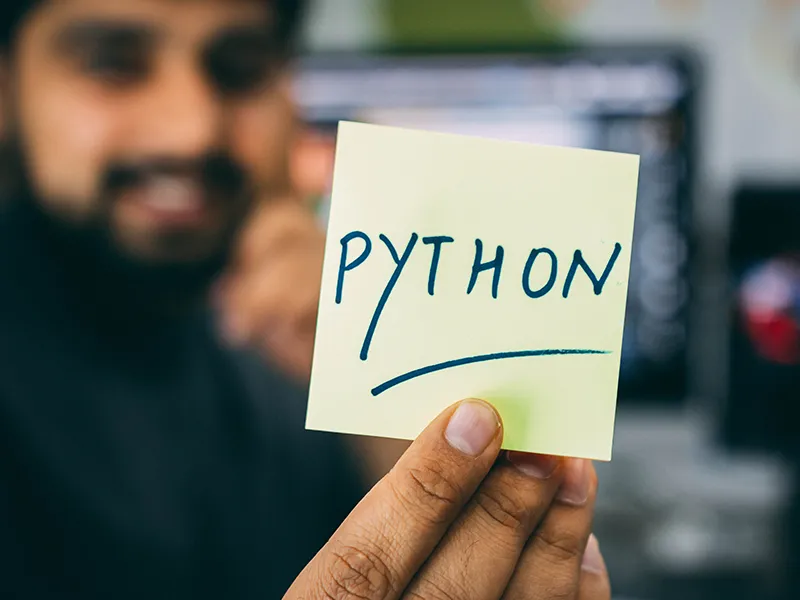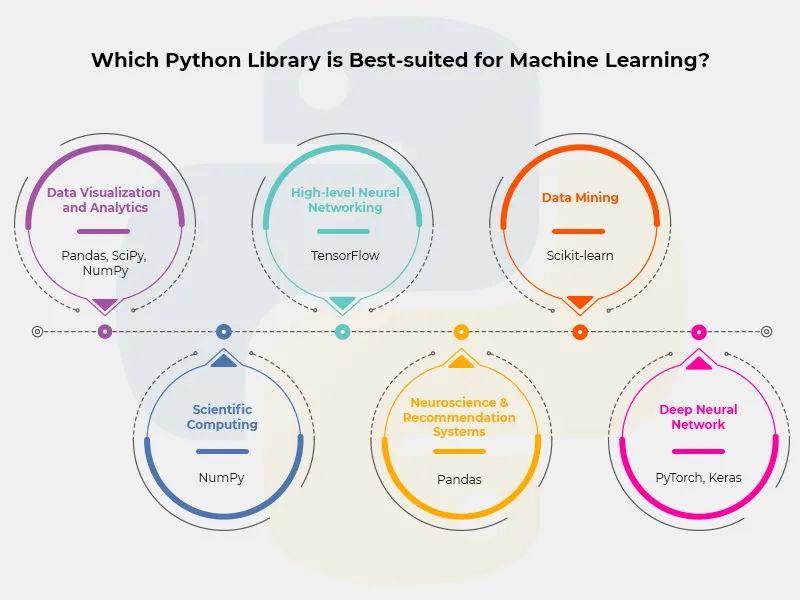Data bind the digital world together and empowers businesses to pave the way for a more optimized future. Newer technologies have unlocked new horizons for companies with personalization, better search functionality, and more competent recommendations. As a result, the customer engagement rate has only improved and is likely to stay as-is.
That is the power of machine learning and artificial intelligence. The convergence of these technologies has multiplied opportunities and widened the application scope for smart enterprises. However, without the third asset, these technologies would have fallen short of impacting Python.
Numerous Python libraries for machine learning are surfacing in recent years. It has positively stirred the ML and AI market and brought several transformations with its innovational capacity. However, being spoilt for choice also has its own drawback. With multiple Python libraries for machine learning available for python programmers, it gets overwhelming to select the right one.
If you are reading this article, we can assure you of detailed information about the best Python libraries for machine learning along with the applications and selection process.
Why is Python for Machine Learning the Best Choice?

Python is recognized as the best programming language for machine learning applications. However, if you are wondering about the underlying reason behind it, let me simplify it for you. Traditionally, machine learning application-based projects are different from other software projects. Here, the difference is not only on the lines of the technology stack but also on the required skills and analytics. In addition to this, ML projects demand stability and flexibility, which Python suffices in a better manner.
Let’s look at the other value addition that makes Python for machine learning the ideal choice:
- Consistency and Simplicity:
Python provides readable and concise code. While machine learning brings complex workflows to the table, Python helps untangle the complexity with its simplicity. In addition to this, the Python programmers find the programming language easy to learn, as the code is interpretable and convenient to build models with for ML.
- Extensive Set of Libraries:
Developing ML and AI algorithms can be time- and thought-consuming, given the multiple layers. Hence, it is vital for the software development agency to put developers on the project to structurize and test the environment using viable coding solutions. In addition, extensive Python libraries for machine learning with pre-written codes helps developers solve the most common programming issues, which expedites the product development process.
- Independent of Platform:
One of the most popular reasons to opt for Python for machine learning is its platform-independent characteristics. Python is supported by multiple platforms, including but not limited to macOS, Windows, and Linux. The programming language can be executed on a common OS, whmakingy for better distribution without an interpreter.
- Huge Community Support:
It won’t be an exaggeration to say that Python is an old yet highly picked programming language. As per a recent survey by Stack Overflow, Python was ranked among the top five most popular languages, implying that finding a Python development software agency for machine learning won’t be a hassle. You can be as creative with the project. In case of deadlocks in between, you can always be backed by the Python community.
What are the Top Python Libraries for Machine Learning?
Python libraries for machine learning have evolved to grow and become highly preferable components for futuristic projects in recent years. Below are some of the best Python libraries for machine learning:
1) NumPy:
NumPy is the best python library for mathematical operations. The NumPy arrays are developed using the homogenous arrays, which further makes them convenient to use. In addition to this, NumPy offers an efficient storage system, thereby improving the way data is handled for the mathematical operations through simple APIs.
Top Advantages of NumPy:
- NumPy uses less memory for data storage.
- The Python library for machine learning can create n-dimensional arrays.
- Applications requiring data analytics can be quickly developed with NumPy.
Top Disadvantages of NumPy:
- NumPy supports ‘nan’ function but does not offer cross-platform support within the Python environment. As a result, comparing values becomes difficult.
- Since the data is allocated in contiguous memory, it often requires shifting. As a result, the insertion and deletion activities prove to be of cost-intensive nature.
2) SciPy:
With the influence of machine learning growing at an exponential rate, numerous Python developers are looking at Python libraries for machine learning for their analytical and scientific capabilities. So, in 2001, it was decided to merge a prominent part of the codes and bits and standardized it for more applications. That is how SciPy was developed as a Python library.
Top Advantages of SciPy:
- The SciPy library provides modules for image optimization, linear algebra, special functions, and integration.
- The data structure of SciPy is multidimensional.
Top Disadvantages of SciPy:
- SciPy requires NumPy when the application is hinged on scientific or data analysis.

3) Scikit-learn:
Scikit-learn is among the highly used Python libraries for machine learning. It is an extensive collection of highly efficient tools used for statistical modeling as well as Machine Learning. SciPy is built chiefly upon NumPy, SciPy, and Matplotib. SciPy utilizes a unified and consistent interface for ML, cross-validation algorithms, and visualization.
Top Advantages of Scikit-learn:
- It features a versatile library with functionalities to predict customer behavior, neuroimage creations, and more.
- Scikit-learn website offers detailed API documentation, serving as an instrument for developers to integrate algorithms on their platforms.
Top Disadvantages of Scikit-learn:
- The other Python libraries are better for in-depth learning.
4) TensorFlow:
TensorFlow is one of the best Python libraries for machine learning. The Python library can be utilized for numerous tasks. However, it has a specialized focus on the inference of deep neural networks. In addition, it features a symbolic math library, dependent on the differentiable and dataflow programming.
Top Advantages of TensorFlow:
- TensorFlow features rich ML algorithms.
- The Python library for machine learning offers a better data visualization capability with the graphical approach.
Top Disadvantages of TensorFlow:
- TensorFlow releases numerous updates as frequently as two to three months. As a result, it proves to be cost-intensive for a user to install and bind with the existing environment.
- The Python library decreases the length of the code. However, it increases the complexity level.

5) Keras:
Keras is an easy-to-use Python library for machine learning. The Python library makes it easy to reduce the cognitive load and offers high grades of consistency and simplicity. It provides actionable and clear feedback upon user error. As a result, Keras provides better productivity, thereby enabling you to try out more ideas.
Top Advantages of Keras:
- Keras is a user-friendly API that offers Deep Learning capabilities.
- The Python library for machine learning holds the ability to develop neural networks with fewer lines of code.
Top Disadvantages of Keras:
- The Python library for machine learning does not support dynamic chart creation options.
- In some cases, the errors offered by the Python library are not practical.
6) PyTorch:
PyTorch uses the Torch library for machine learning. It can develop even the most complex neural networks, owing to its core data structure. It is often characterized as the Python library with flexibility and speed and is gradually becoming a go-to Python library for various industries. In addition to this, PyTorch offers high computation power and is easy to learn.
Top Advantages of PyTorch:
- The Python library can even lead to the distribution of various computational tasks using GPUs or CPUs.
- With tools such as ipdb and pdb, PyTorch makes it easy to debug. It uses IDE PyCharm for debugging.
Top Disadvantages of PyTorch:
- It has been recently released (2016). As a result, it has only fewer users as compared to the other Python libraries.
- Developers often find the limitations with the lack of monitoring and visualization tools.
7) Pandas:
Pandas is a powerful and flexible data analytics and data manipulation tool for machine learning. It offers a well-structured format similar to R language and data frame objects. It enables importing of data through numerous file formats such as Microsoft Excel, SQL, JSON, and more. Pandas sports easy handling of missing data.
Top Advantages of Pandas:
- Pandas features an exceptional representation of data.
- It requires less coding and gets more work done.
Top Disadvantages of Pandas:
- While working with the advanced level of Pandas, you might not be able to switch seamlessly between Pandas and Python code.
- Pandas usually deal with two-dimensional matrices. However, it is not compatible with three-dimensional matrices.
8) Matplotib:
Matplotib features 2D plotting capabilities for data visualization. The Python library is used with other libraries such as NumPy, IPython, and SciPy. It offers high-quality images as well as plots in numerous formats—pgf, png, pdf, and more. Matplotib also supports histograms, paths, pie charts, bar charts, and more.
Top Advantages of Matplotib:
- Matplotib offers object-oriented API for embedding plots to applications through GUI toolkits such as Tkinter, Qt, wxPython, or Gtk.
- It is an easily interpretable library.
Top Disadvantages of Matplotib:
- Matplotib can be difficult to learn for beginners.
What are the Top Applications of Machine Learning with Python?
Machine learning with Python is evolving faster than you think. Since Python in machine learning is a general-purpose language, it can perform a set of complex tasks. It can develop prototypes quickly and enables you to test the product for machine learning.
Likewise, there are multiple areas tapped with the convergence of machine learning and Python. Below are the top applications of machine learning with Python:
- Image Recognition:
Machine learning enables automatic identification of the contents of a picture.
- Speech Recognition:
Speech recognition is one of the most crucial use cases of machine learning with Python.
- Recommendation Engine:
Growing in popularity for customer-centric applications, machine learning with Python can create customer-behavioural patterns based on their search history.
- Deepfakes:
Machine learning can synthesize a video or a picture, depending on the input provided by the data, video, or picture.
- Self-driving Cars:
Machine learning can develop a better routing path for users without any input.
- Data Filter:
For a chunk of data, machine learning with Python can filter out the redundant data from spam and malware.
Did you know that machine learning is evolved to showcase its skill in agriculture?
Which Python Library is Best-suited for Machine Learning?

We have seen the eight best Python libraries for machine learning. However, every Python library has a designated purpose in a project. So, the question is, how to select the best Python library for machine learning?
Know your project thoroughly and the role of machine learning in your product. Based on your analysis, look for the Python library offering the type of characteristics your end product seek. Below are the best attributes of different Python libraries:
Depending on the characteristic, you can match the product requirement and move ahead with your project. Scientific Python packages–Matplotib, Scipy, and NumPy, can be installed through programs running on Python. The programming language is highly reliable for machine learning. Since machine learning is still developing itself and growing continuously, several languages dominate the space. However, Python emerges as a clear winner, owing to its dynamic nature and simplicity.


